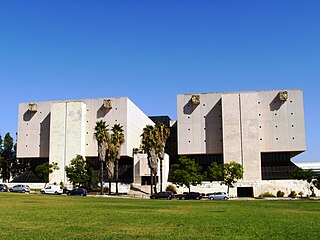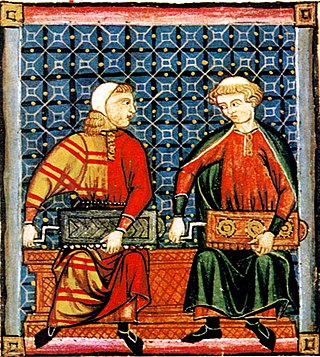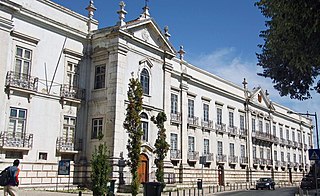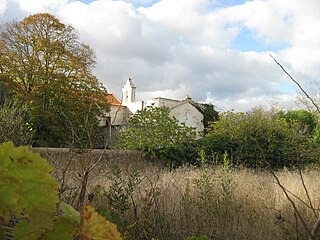
| History of Portugal |
|---|
 |
| Timeline |
This is a list of archives in Portugal.

| History of Portugal |
|---|
 |
| Timeline |
This is a list of archives in Portugal.
There are many other archives in Portugal, such as:

The Castle of Salir is an Almohad fortress, located in the civil parish of the same name, 16 kilometres from the municipality seat of Loulé in the Portuguese Algarve.

The National Archive of Torre do Tombo is the Portuguese national archive located in the civil parish of Alvalade, in the municipality of central-northern Lisbon. Established in 1378, it was renamed the Instituto dos Arquivos Nacionais in 2009.

Luís Vaz Pereira Pinto Guedes, 2nd Viscount of Montalegre, was a Portuguese soldier, who served on the absolutist side in Portugal's Liberal Wars.

In the Middle Ages, the Galician-Portuguese lyric, also known as trovadorismo in Portugal and trobadorismo in Galicia, was a lyric poetic school or movement. All told, there are around 1680 texts in the so-called secular lyric or lírica profana. At the time Galician-Portuguese was the language used in nearly all of Iberia for lyric poetry. From this language derives both modern Galician and Portuguese. The school, which was influenced to some extent by the Occitan troubadours, is first documented at the end of the twelfth century and lasted until the middle of the fourteenth, with its zenith coming in the middle of the thirteenth century, centered on the person of Alfonso X, The Wise King. It is the earliest known poetic movement in Galicia or Portugal and represents not only the beginnings of but one of the high points of poetic history in both countries and in Medieval Europe. Modern Galicia has seen a revival movement called neotrobadorismo.
Campo Grande was a Portuguese parish (freguesia) in the municipality of Lisbon. At the administrative reorganization of Lisbon on 8 December 2012 it became part of the parish Alvalade.

Penha de França is a freguesia and typical quarter of Lisbon, the capital of Portugal. Located in the historic center of Lisbon, Penha de França is north of São Vicente, east of Arroios, south of Areeiro, and west of Beato. The population in 2021 was 28,475.
Fort of the Cavalas is a fort situated in the civil parish of São Sebastião in the municipality of Angra do Heroísmo, in the Portuguese archipelago of the Azores.

The Convent of Our Lady of Mount Carmel is a medieval carmelite convent and church complex in the civil parish of Lagoa in the municipality of Lagoa in the Portuguese Algarve. The original convent was all but destroyed in the 1755 Lisbon earthquake. After the extinction of the religious orders in Portugal in 1834, the property was taken over by a signeurial family which continued to provide church services.

The Fort of Greta is a medieval fortification, whose remnants are located on the cinder cone of Monte da Guia, along the southern coast of the civil parish of Angústias, in Horta, island of Faial, in the Portuguese Azores.
The following is a timeline of the history of the city of Lisbon, Portugal.

Carlos Julião was a Luso-Italian artist and engineer of the Portuguese colonial army, working as a fortress inspector during the second half of the 18th century and beginning of the 19th century. He is more known for his watercolor drawings, portraying the different racial and social types inhabiting the Portuguese empire, as well as the period and methods of mining in Brazil.
The Fort of Greta is a fort along the promontory of Santa Catarina, on the western edge of the Bay of Mós, in the civil parish of Vila de São Sebastião, in the municipality of Angra do Heroísmo, on the Portuguese archipelago of the Azores.

The Arquivo Histórico Ultramarino of Portugal preserves archives related to the Portuguese Empire. It is located in the Palácio da Ega on Calçada da Boa-Hora in the city of Lisbon, near the Rua da Junqueira in the parish of Alcântara. The Instituto de Investigação Científica Tropical of the governmental Ministry of Science, Technology and Higher Education administers the archives. Prior to 1973, the Overseas Ministry oversaw it.
The following is a timeline of the history of the city of Braga, Portugal.
The following is a timeline of the history of the city of Coimbra, Portugal.
The following is a timeline of the history of the city of Funchal, Madeira, Portugal.
The following is a timeline of the history of the municipality of Setúbal, Portugal.

José Curry da Câmara Cabral, better known simply as Curry Cabral, was a Portuguese physician, and one of the most famous medical researchers and professors in the country. An eminent clinician, he was one of the most prestigious figures in Portuguese medicine in the early 20th century, alongside Sousa Martins, Manuel Bento de Sousa, and Oliveira Feijão.

Maria Leontina Mendes Ferreira Cabral Hogan, also known as Leontina de Cabral Hogan was a Portuguese medium, spiritist, and feminist activist and member of the National Council of Portuguese Women.
Portugal.—Portuguese royal records are in the monastery of Sao Bento at Lisbon....It includes the registers of the Chancery since the 13th century, and a large number of documents subsidiary to them. In addition to this repository there are collections at the various ministries; from the records of the Ministry for Foreign Affairs, Borges de Castro, and afterwards Judice Biker, published their Collecção dos Tratados . . . entre a Corona de Portugal e as mais potentias. There are three volumes of transcripts from Portuguese records in the English Public Record Office.
Rede Portuguesa de Arquivos